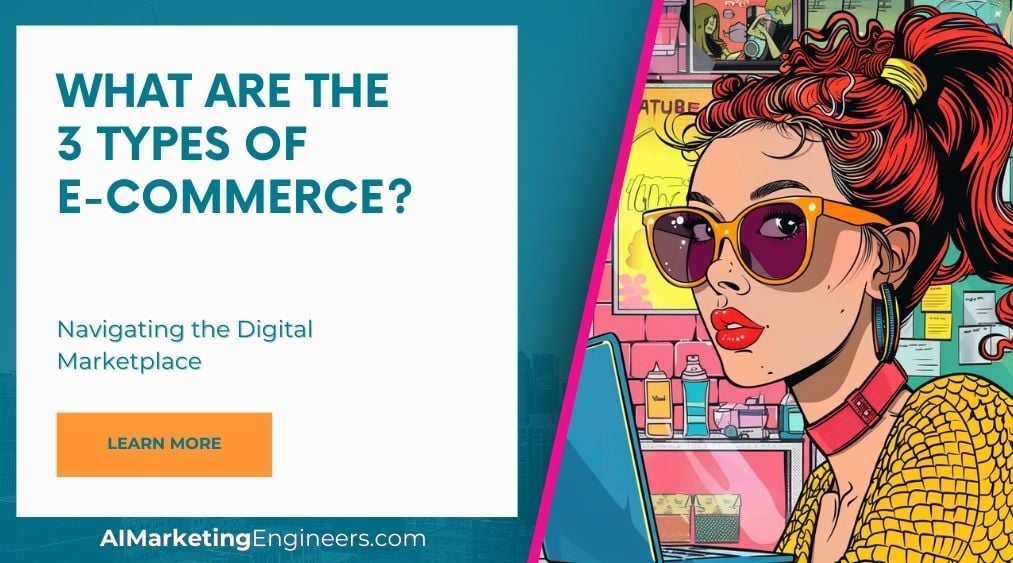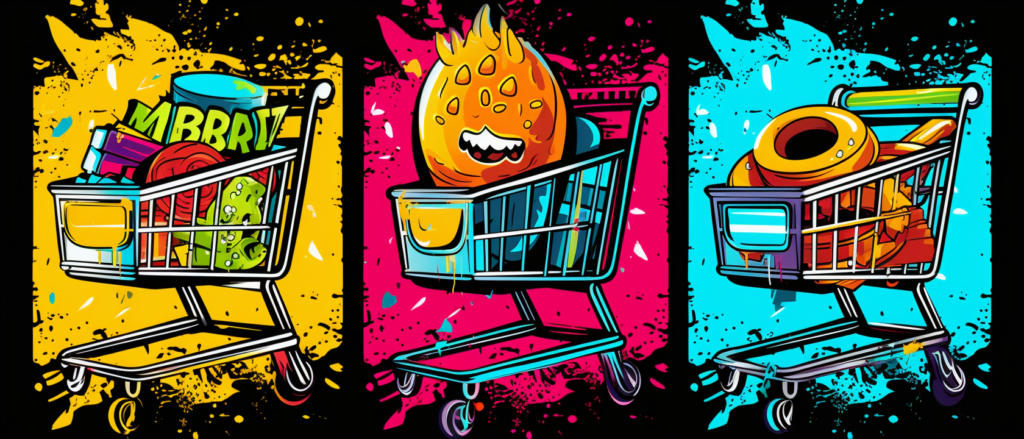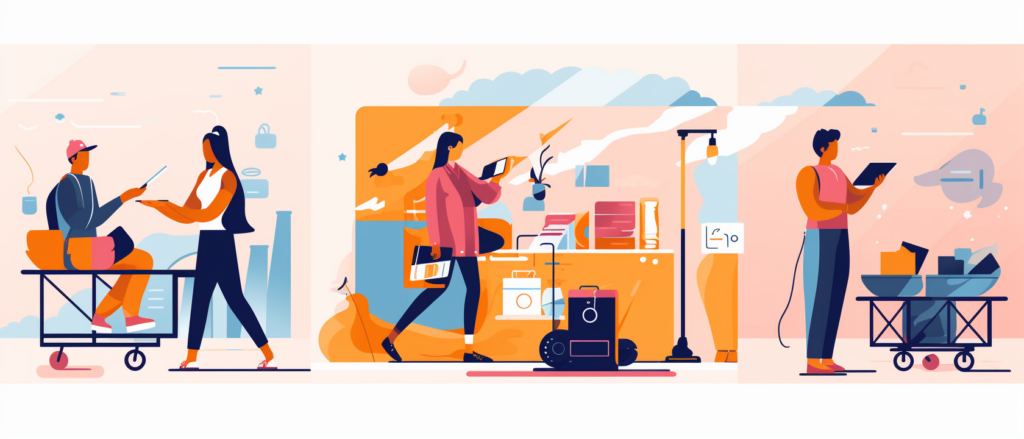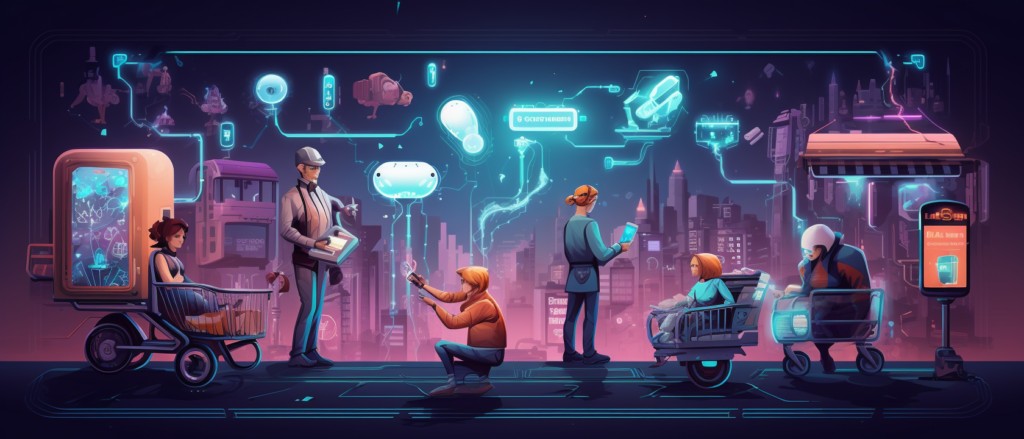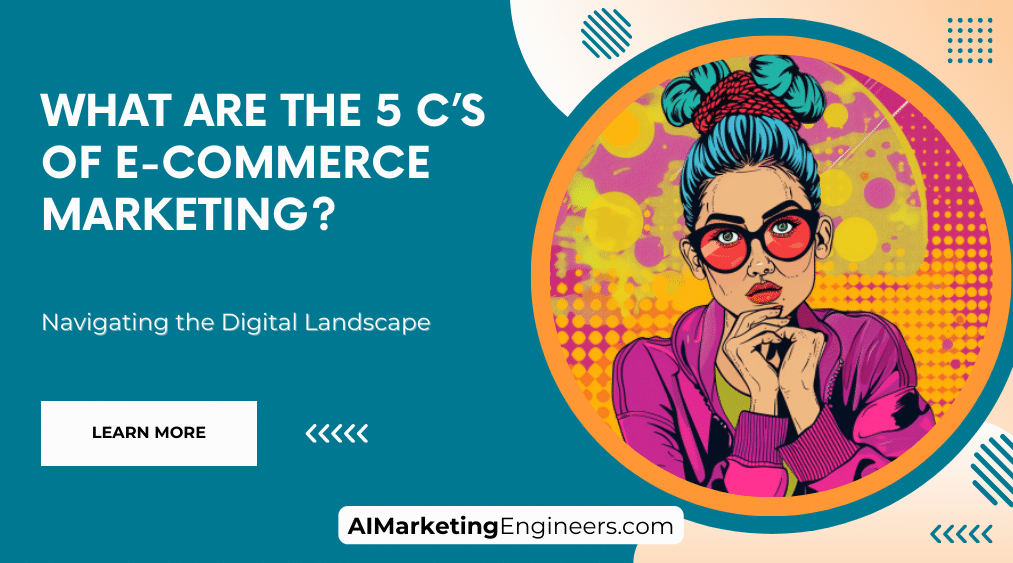Key Takeaways
✅ Business-to-Consumer (B2C): Retail therapy gone digital! B2C e-commerce is where your favorite online shops live. Imagine a world where every store caters to your personal needs, and these stats don’t lie: with over 60% of consumers preferring online shopping, your business could tap into that vast market.
✅ Business-to-Business (B2B): Think big deals and even bigger quantities. B2B is all about those heavyweight transactions between companies. Did you know that B2B e-commerce is projected to hit USD 1.8 trillion by 2023? That’s a lot of zeros! Are you ready to bulk up your sales?
✅ Consumer-to-Consumer (C2C): It’s like the neighborhood garage sale, but online and with way more traffic. C2C is the go-to place for selling your gently used items or showcasing your craftiness. With platforms like eBay having over 182 million users, someone out there might be searching for that quirky thing you’re selling.
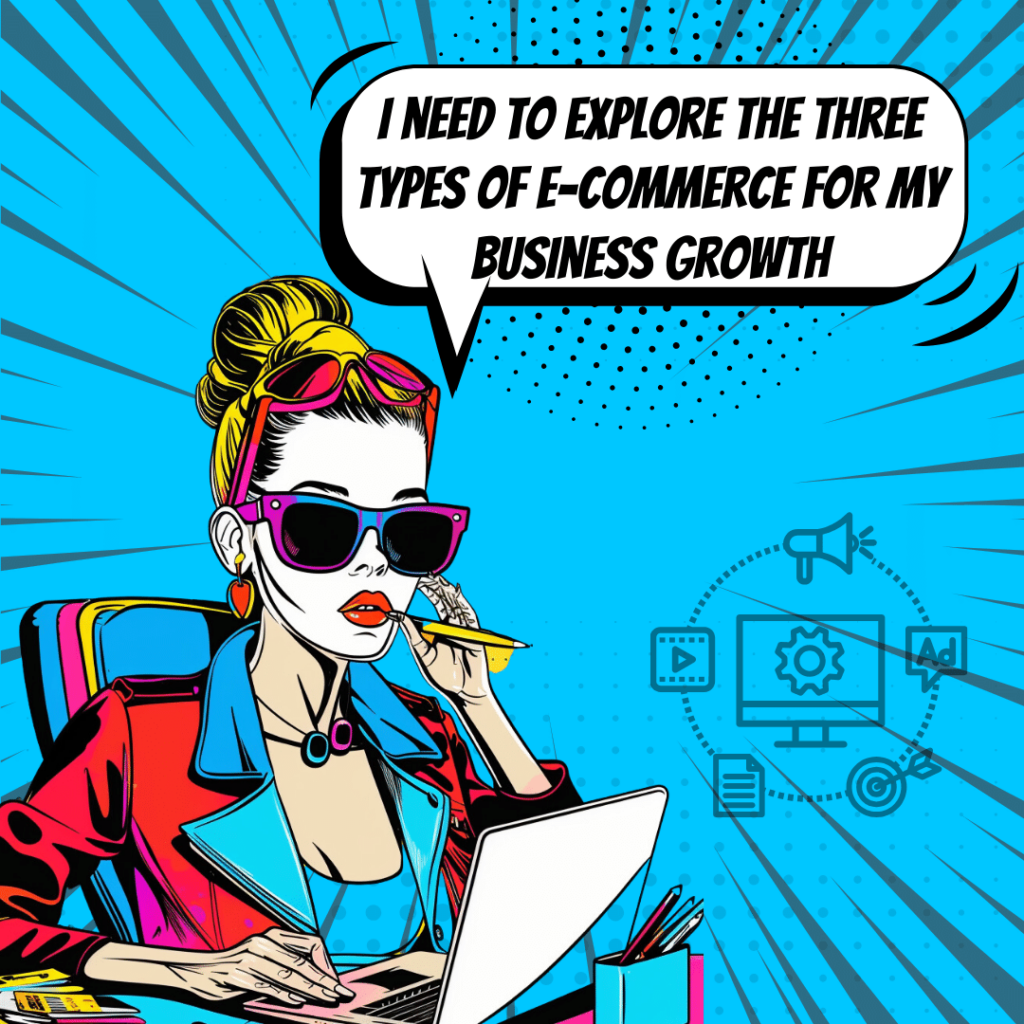
Introduction
Ever wondered what magic lies behind your screen that lets you buy a new book or find a plumber with just a few taps and clicks? That’s the wonder of e-commerce, and it’s a game-changer in our modern marketplace. But did you know that not all digital shopping carts are the same? There are three key players in this online bazaar: Business-to-Consumer (B2C), Business-to-Business (B2B), and Consumer-to-Consumer (C2C). Each has its own flavor and plays by different rules. Curious yet?
Stick around as we unravel these three e-commerce models, their quirks, and perks. Plus, we’ll share some modern trends that could spruce up your sales strategy. Whether you’re a seasoned online shopper or a business owner looking to boost that bottom line, there’s always something new on the horizon. And who doesn’t love a little insider knowledge? It’s like finding a hidden discount code, but for your business strategy. Ready to power up your online presence?
Top Statistics
| Statistic | Insight |
|---|---|
| Global Retail E-commerce Sales: Surpassed $4.9 trillion in 2021 and are projected to exceed $7.5 trillion by 2026. (Source: eMarketer, 2022) | This explosive growth indicates an ever-increasing market that businesses can’t afford to ignore. |
| B2B E-commerce Market Size: Valued at $14.9 trillion in 2020, expecting to hit $25.6 trillion by 2028. (Source: Grand View Research, 2021) | Shows the immense potential for businesses to scale up and innovate in the B2B space. |
| B2C E-commerce Dominance: Accounted for approximately 80% of online global sales in 2021. (Source: Statista, 2022) | Highlights how consumer-facing online shops are still the king of the digital sales hill. |
| Mobile E-commerce Sales Projections: Estimated to make up nearly three-quarters of e-commerce sales by 2025. (Source: Invesp, 2022) | It’s clear: If you’re selling online and you’re not thinking mobile-first, you might be left behind. |
| Social C2C Growth: Platforms like Instagram Shopping and Facebook Marketplace are expanding the reach for C2C opportunities. (Source: Hootsuite, 2022) | Underline the importance of social media presence for peer-to-peer sellers, it’s where the market is moving. |
Unpacking Business-to-Consumer (B2C) E-commerce
When you hear the phrase online shopping, it’s the B2C model that’s likely popping into your head. It’s your virtual mall, with endless aisles and no closing hours. What sets B2C apart is how personal the shopping experience can be. Think about the last time you shopped online; were there recommendations waiting just for you? That’s B2C in its prime, getting to know what you like and dislike, a bit like a friend who knows your taste. And then, it’s not just about buying; it’s the convenience that comes with it. Do you realize how simple it has become to return that shirt that didn’t fit right? It’s B2C’s commitment to customer satisfaction that keeps us coming back.
Exploring Business-to-Business (B2B) E-commerce
In the B2B e-commerce world, it’s less about impulse buys and more about the long haul. It’s two businesses shaking hands, except it’s digital, and the handshake can cross continents. Have you considered the magnitude of transactions that happen when a manufacturer restocks a retailer? While B2C focuses on your individual needs, B2B e-commerce is about fulfilling the needs of an entire business. It’s about forming those lasting partnerships that help businesses thrive. And with digital platforms making these connections easier, have you thought about the potential for businesses to scale up way faster than before?
The Intricacies of Consumer-to-Consumer (C2C) E-commerce
C2C e-commerce brings to mind the adage, “One man’s trash is another man’s treasure.” It’s a digital marketplace for the likes of you and me to sell items we no longer need. Trust is the currency here, alongside actual money. Ever sold something on eBay and waited anxiously for a positive review? That’s the trust factor at work. You’re not just trading goods; you’re building a reputation, piece by piece. It’s this level of personal interaction and community that makes C2C stand out. Curious about how such platforms keep transactions safe and build that trust? It’s a dance between user vigilance and platform policies.
The Rise of Hybrid E-commerce Models
Enter the world of hybrid e-commerce models, where the boundaries between B2C, B2B, and C2C begin to blur. Are you familiar with Amazon Business? It sells to both consumers and businesses, juggling roles and catering to a broader audience. And it’s not just about being versatile; it’s about maximizing opportunities. Think about what it means when a platform offers personal buying experiences and wholesale options. As a small business owner, you could source products and shop for your personal needs all in one place. Does this blend create complexity? Absolutely. But the creative solutions it offers can be groundbreaking.
The foundations of e-commerce are entrenched in these models, each catering to specific interactions and creating ecosystems that define the modern shopping experience. Each model has its quirks and features, shaping the path consumers and businesses take in the digital marketplace. What’s your take – have you engaged with all these models, and how have they influenced your buying or selling decisions?
AI Marketing Engineers Recommendation
Recommendation 1: Focus on Mobile Optimization for Business-to-Consumer (B2C) E-Commerce: With over half of internet traffic shopping from a mobile device, ensuring your B2C platform is optimized for mobile isn’t just an option; it’s critical. Opt for responsive design, fast loading times, and streamlined checkout processes. Prioritize a mobile-first approach not just in design, but also in marketing strategies – think short, compelling content and easy-to-click calls-to-action. Have you checked your website’s performance on a smartphone lately?
Recommendation 2: Leverage Personalization in Business-to-Business (B2B) E-Commerce: B2B buyers are seeking personalized experiences akin to B2C. By employing AI and machine learning tools, you can offer personalized product recommendations, customized pricing, and tailored content. These strategies can increase engagement and conversion rates. How are you making your B2B clients feel like they’re your only customer?
Recommendation 3: Integrate Social Commerce Features for Consumer-to-Consumer (C2C) Platforms: Social media platforms are turning into bustling marketplaces. Tap into this trend by integrating your C2C platform with social commerce capabilities, such as Facebook Marketplace or Instagram Shopping. This approach makes it easier for users to discover, share, and purchase products within the social media environment where they’re already engaged and comfortable. Are you meeting your buyers where they already hang out?
Conclusion
Well, we’ve been on quite the journey, haven’t we? Exploring the bustling world of e-commerce is a lot like visiting a vast, virtual marketplace where every stall offers something different. From the handy, everyday items to the big, bulk buys, e-commerce has got it all. So, what have we learned?
At its heart, e-commerce is about connecting — businesses to consumers, businesses to other businesses, and people to… well, other people. In the end, whether it’s B2C, B2B, or C2C, it’s all about making those connections as smooth as possible. Remember how we talked about B2C being all about the individual shopper’s experience? On platforms like Amazon and Walmart.com, they’re king. Then we’ve got B2B, where it’s all about forming solid relationships and talking big deals, like on ThomasNet. Finally, C2C is where you and I can be both the buyer and the seller, thanks to sites like eBay or Facebook Marketplace.
And let’s not forget those hybrid models. They mix things up to offer businesses and savvy shoppers alike the best of all worlds. But no matter which type of e-commerce model feels like the right fit for you or your business, there’s no denying the importance of understanding the lay of the land.
So, what’s your next move? Are you ready to dive into the world of e-commerce, or maybe you’re looking to tighten up your existing online business? Got any worries about taking the plunge or dreams of what success in this digital marketplace could look like? Whatever your hopes or fears, one thing is clear — whether you’re buying, selling, or a bit of both, the opportunities in e-commerce are endless. Let’s keep the conversation going, and who knows? Maybe together, we’ll find the perfect fit for your e-commerce adventure.
FAQs
Question 1: What are the three main types of e-commerce?
Answer: The big three are Business-to-Consumer (B2C), Business-to-Business (B2B), and Consumer-to-Consumer (C2C).
Question 2: Can you explain each type in more detail?
Answer:
– B2C (Business-to-Consumer): Imagine you’re shopping online for shoes or streaming your favorite show. That’s B2C, where businesses sell straight to folks like you and me.
– B2B (Business-to-Business): This is when one company’s bread and butter is supplying other companies, often in big quantities. Think of a restaurant buying bulk spices or a manufacturer sourcing parts.
– C2C (Consumer-to-Consumer): Got an old guitar or a vintage comic book to sell? Platforms like eBay that let regular people sell to others are what C2C is all about.
Question 3: Are there any other important subcategories within these types?
Answer: Yep, we’ve got m-commerce that’s all about using your phone to shop or sell, social commerce that’s taking off on platforms like Instagram, and subscription commerce – think those makeup boxes or dog treats that come monthly.
Question 4: How do I choose which type of e-commerce is best suited for my business?
Answer: Choosing the right model is like picking a team jersey – it’s got to match your game plan. Think about who you’re selling to, what you’re selling, and how you want to grow. Sell directly to customers? B2C. Selling to other businesses? B2B might be your jam.
Question 5: What are the advantages of e-commerce compared to traditional brick-and-mortar stores?
Answer: Selling online? You can reach folks in every corner of the world, save on shop costs, and get a treasure trove of data on what your customers love.
Question 6: How can I ensure my e-commerce business remains competitive in today’s landscape?
Answer: The trick is to make sure shopping with you is a breeze, use social media to connect, use what you know about your customers to get personal, and always keep your customer service top-notch. Don’t forget to stay on top of the latest e-commerce tips and tech.
Question 7: What are some best practices for securing my e-commerce platform?
Answer: Keep things locked down with SSL certificates, stay sharp with fraud detection, keep all your digital locks updated, teach your team the cybersecurity handshake, and help your customers keep an eye out for the sketchy stuff.
Academic References
- Kalakota, R., & Whinston, A. B. (1997). The Strategic Implications of Electronic Commerce. International Journal of Electronic Commerce, 1(3), Spring 1997. This foundational paper presents the concept of Business-to-Consumer (B2C) e-commerce, highlighting how it’s poised to transform traditional retail by bringing more convenience, a wider selection of products, and lower prices to consumers.
- Kauffman, R. J., & Anderson, D. M. (2000). Strategic implications of the Internet for business-to-business markets. Management Science, 46(10), October 2000. In this insightful piece, the authors discuss the ways Business-to-Business (B2B) e-commerce can streamline the supply chain, cut costs associated with transactions, and foster greater collaboration between businesses, also noting the strategic obstacles faced when adopting B2B e-commerce solutions.
- Li, H., & Gopal, R. (2004). Electronic marketplaces and electronic hierarchies: Value dimensions of buyer power in electronic networks. Information Systems Research, 15(4), December 2004. This research looks into Consumer-to-Consumer (C2C) e-commerce, exploring how online marketplaces like eBay and Craigslist are allowing individuals to sell directly to one another. The authors reveal vital elements that influence consumer activities in these spaces, such as trustworthiness, standing, and the ease of finding what you’re after.
